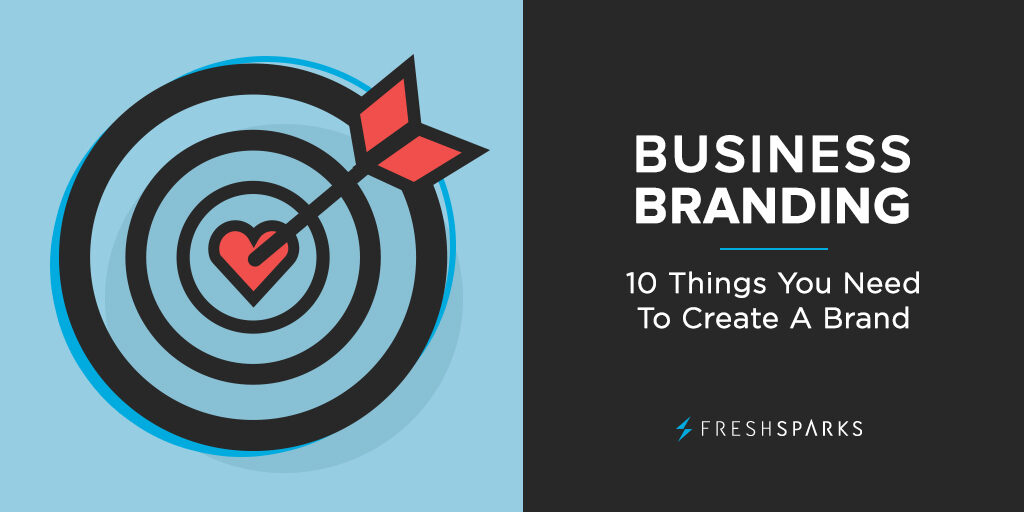
Smart business branding is critical today to stand out from the competition. You have to be distinct, or you’ll get lost in a sea of companies out there.
What’s more, your brand needs to target the right customers and hone in on an audience that will benefit most from your products or services.
Finally, your message needs to be communicated clearly to those specific people. They’re the ones who will take action when they believe in what you do and what you stand for.
[click_to_tweet tweet=”Your brand has to be distinct and memorable, or you’ll get lost in a sea of companies out there. #branding #smallbiz” quote=”Your brand has to be distinct and memorable, or you’ll get lost in a sea of companies out there.”]
Success with branding in marketing and sales comes down to excelling in all three of those areas I mentioned:
- Standing out from the competitors
- Targeting the right audience
- Communicating your story consistently
How well are you doing any of them? Is it time to work on your brand strategy?
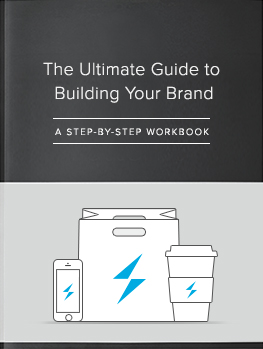 |
THE ULTIMATE GUIDE TO BUILDING YOUR BRAND Use our step-by-step workbook with tips, templates, and guidance to help build a brand for your business! Find your target audience, research competitors…and much more. |
Before you assess, let’s quickly review the definition of business branding.
What is branding for business?
In a nutshell, business branding is about creating a comprehensive message for your company and product or service, using names, logos, slogans, copy and other collateral.
Branding is actively creating the perception you hope consumers have as they come into contact with, and experience your company, product or service.
I like to break branding a company down into three core phases:
- Brand Strategy
- Brand Identity
- Brand Marketing
Brand Strategy is a plan that focuses on the long-term development of your purpose and impact.
Your Brand Strategy will map out how you are different, trustworthy, memorable, and likable by your ideal customer. It will convey your purpose, promises, and how you solve problems for people.
You can think of Brand Strategy as the blueprint for how you want the world to see your business.
Brand Strategy is a critical and foundational piece for building a successful brand. It’s one of the areas that most businesses overlook, because they jump right into the design and marketing.
Don’t make this mistake! >> Learn how to create an impactful Brand Strategy here
Brand Identity is the way that you convey this to the public with visuals, messaging, and experience.
Your brand identity should be applied across all channels consistently. It is the way that your business becomes recognizable. This includes your logo, colors and fonts, website design, content, advertising, print or packaging, and more. And these assets are all part of your branding package, which is necessary to strengthen your brand across different channels.
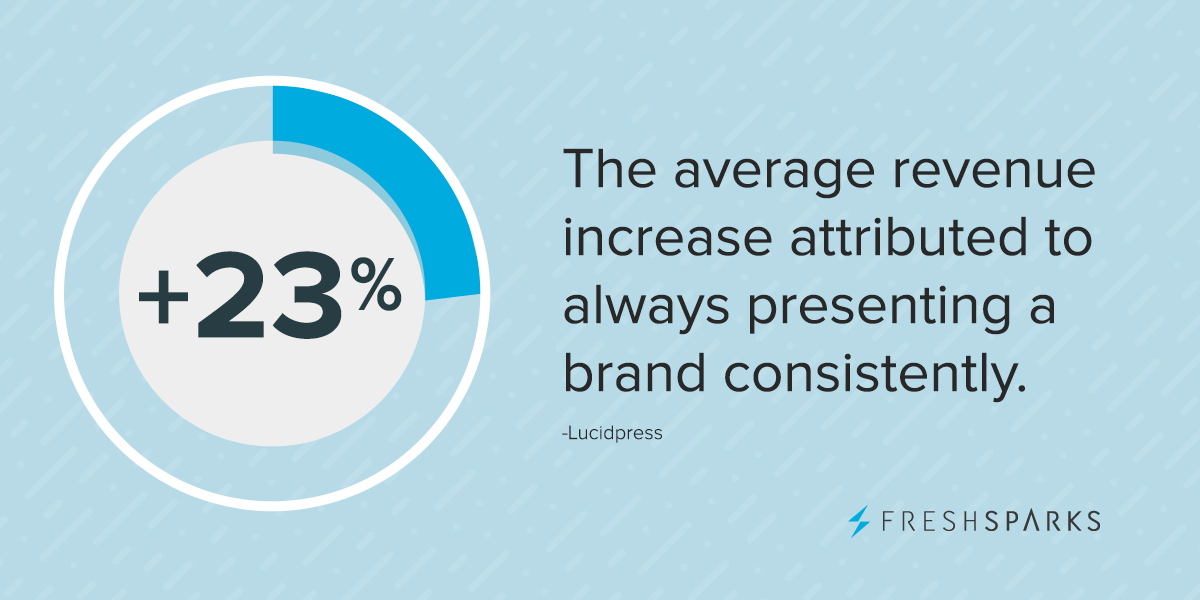 Source: LucidPress
Source: LucidPress
In fact: consistent brand presentation across all platforms can increase revenue by up to 23 percent.
Finally, Brand Marketing is the way that businesses or organizations highlight and bring awareness to products or services by connecting values and voice to the right audience through strategic communication.
If you are looking for how to create a business brand that people love, follow this guide for the do’s and don’ts of small business branding strategies.
[click_to_tweet tweet=”Consistent #brand presentation across all platforms can increase revenue by up to 23 percent.” quote=”Consistent brand presentation across all platforms can increase revenue by up to 23 percent.”]
Our Best Business Branding Ideas (Take Notes!)
When coming up with the best branding strategies for your branding business plan, keep it simple. Business branding isn’t rocket science, but it does require creativity and strategic thinking.
Sometimes, you will just hit that magic spot with your customers.
Other times, you will have to work at it to find the right brand voice or personality.
No matter what, the fact that you are considering a brand building process right now is a positive thing!
I firmly believe the future of a successful business is becoming a BRAND.
A brand is THE biggest asset your company will own—and the most valuable.
Here are some of the best business branding ideas to get you started:
1. DO: Find inspiration from other brands
Take the time to review what your competitors are doing. Notice what they are doing right, and what they might be doing wrong.
Look at a competitor closely in these areas:
- Brand identity (how they appear or sound)
- Product or service offering (quality, features, benefits)
- Website user experience (navigation, call-to-action, messaging)
- Content publishing (blogs, videos, case studies, lead magnets)
- Social media (size of community, engagement, content types, frequency)
- Advertising (print, display, PPC, radio/TV, direct mail)
You should consider doing a SWOT analysis for your business branding, supported by competitor research.
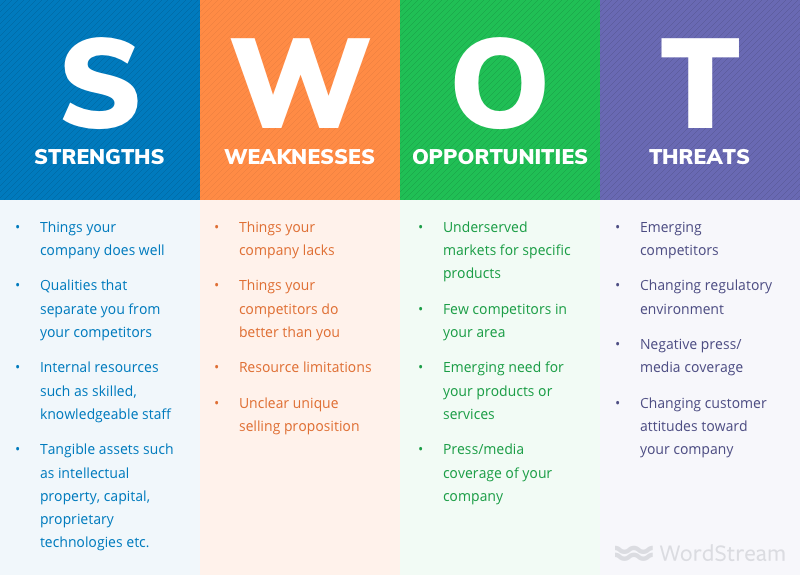 Source: WordStream
Source: WordStream
Perhaps a competitor is using imagery in a certain way that can inspire what you do with your own brand. Does it scream “quality”? Did it gain a lot of likes, comments, shares? Is it super unique from what else is out there?
If they have an online shop, what is the ecommerce user experience like?
Make notes about why you think something is working well for your competitor. Then, strategize on how your brand can do it BETTER.
Alternatively, you may find that a competitor message is not very clear or straightforward. Leverage that gap when creating your own brand story. This makes it easier for customers to choose you over them when making a decision.
DON’T: Rip off other brands
Getting inspiration is one thing, but outright plagiarism is another story. You cannot steal or use another business brand identity. This may seem like common sense, but it isn’t always. You’d be surprised at how many people think they can just go ahead and use a logo because, well, they aren’t in the same industry or a competitor.
Another poor tactic is to try to confuse people by making your small business branding very, very similar. Don’t do it.
You would be obviously ripping off Starbucks if called your coffee shop “Bucksstar Coffee” with green and white in your branding. This really happened, folks.
2. DO: Understand who your customer is
One of the more difficult things with business branding development is to commit to a target audience. It’s important to visualize what an ideal customer within your audience looks like.
We call this a buyer persona. It’s a fictional customer but based on real data about your existing consumers coupled with market research.
Here’s an example of what we create for our brand agency clients:
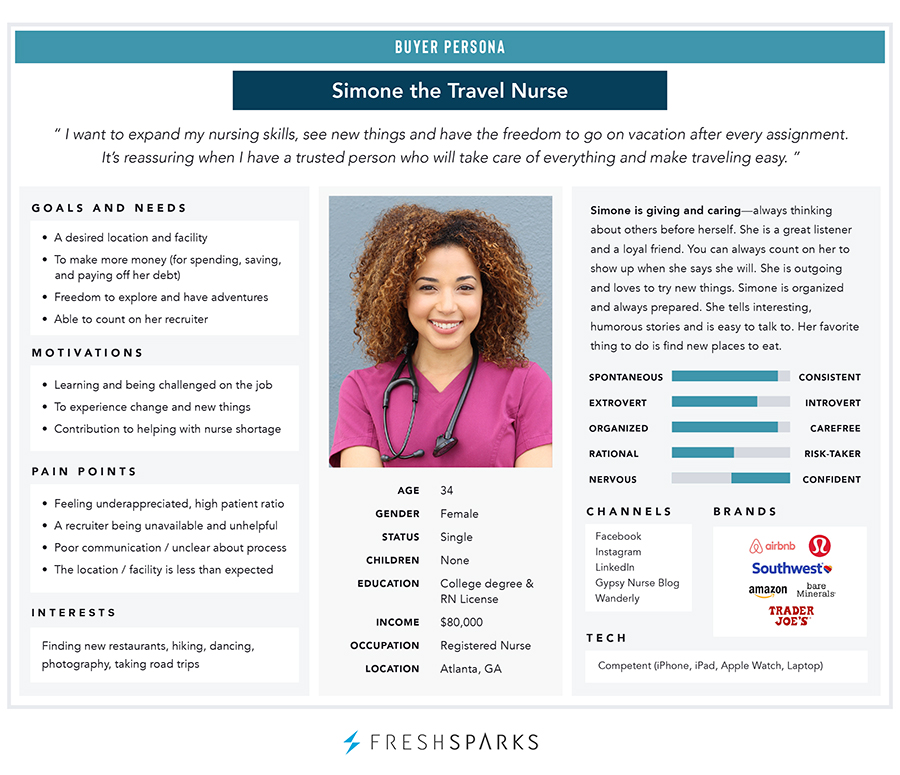
Now, if you’re a new company with little to no sales data, it helps to look at competitors and make educated assumptions. Check out their reviews and social media engagement. Or, interview potential customers–the conversations and feedback will be invaluable for your target audience development.
If you are an existing business, it’s important to gather an understanding of who you are already helping with your product or service. Whose pain point does your business exactly solve for already?
Your buyer persona will have a name. They’ll have a personality, lifestyle, motivations, and frustrations (this is where your brand can guide them!). Creating a complete picture ensures that you can develop business branding ideas to meet their exact needs.
DON’T: Try to be everything to everyone.
Your brand can’t be everything to everyone.
Without specificity, you become nothing to no one.
Find a niche that you can best serve with your product or service.
Here are a few ways to help hone in on your ideal customer:
- First, eliminate who isn’t your audience
- Look at Google Analytics if you have a website
- Conduct a survey to existing customers
- Conduct a survey on social media
- Have a real conversation with a customer
[click_to_tweet tweet=”Your brand can’t be everything to everyone. Without specificity, you become nothing to no one. #branding #smallbiz” quote=”You can’t be everything to everyone. Without specificity, you become nothing to no one.”]
3. DO: Have a professional logo designed
No matter what size business you have, it deserves a professional brand identity design. A freelance graphic designer or a branding agency for small business can create a brand logo.
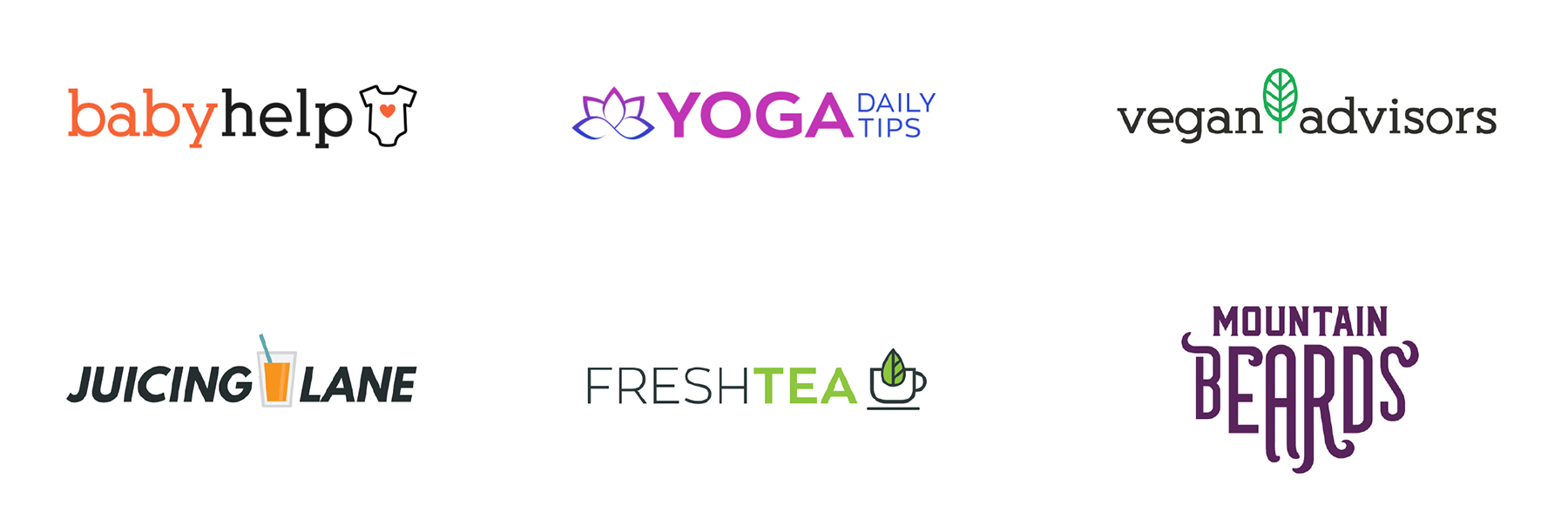 Source: FreshSparks
Source: FreshSparks
The largest creative agencies working with the top brands will charge hundreds of thousands of dollars (sometimes millions!), for comprehensive brand development.
For a smaller business or startup, don’t fret—there are options for branding companies for small business. Expect to pay a thousand dollars (or more) for a great logo, style guide, and collateral to go with it.
Sometimes, you can find cheaper graphic designers online, but keep your expectations in check. You will get what you pay for. It’s worth investing in a professional logo at the beginning (or for a redesign).
When in doubt, remember what Paul Rand said:
“Design is the silent ambassador of your brand.”
So make it exceptional!
As you look to hire someone for your logo design, ensure they provide these things at the very least:
- Logo in vector format (EPS)
- Color palette and fonts
- Brand style guide
Some agencies also provide added materials with a logo design, such as business cards, social media profile graphics and other collateral.
When doing your research on designers or agencies, find out what else can be included in a complete brand identity package.
[click_to_tweet tweet=”“Design is the silent ambassador of your brand.” -Paul Rand #branding” quote=”“Design is the silent ambassador of your brand.” -Paul Rand”]
DON’T: Overthink your logo
Typically, half of small business owners have some kind of vision for their logo. The other half are open to creative ideas—and know what they like when they see it.
In either case, the logo design does not have to be complicated, literal, or super fancy.
 Source: JUST Creative
Source: JUST Creative
When reviewing concepts from a designer, ask yourself if the logo truly is:
- Simple
- Memorable
- Timeless
- Versatile
- Appropriate
4. DO: Create a brand slogan or tagline
A slogan or tagline is a short phrase that exemplifies the essence of your brand, its personality, and positioning. It does not have to apply directly to your products.
For example, one of the most famous business branding slogans is Nike’s “Just Do It.”
Those three words have nothing directly to do with shoes, but the Nike slogan is memorable and conveys the essence of the brand. It motivates!
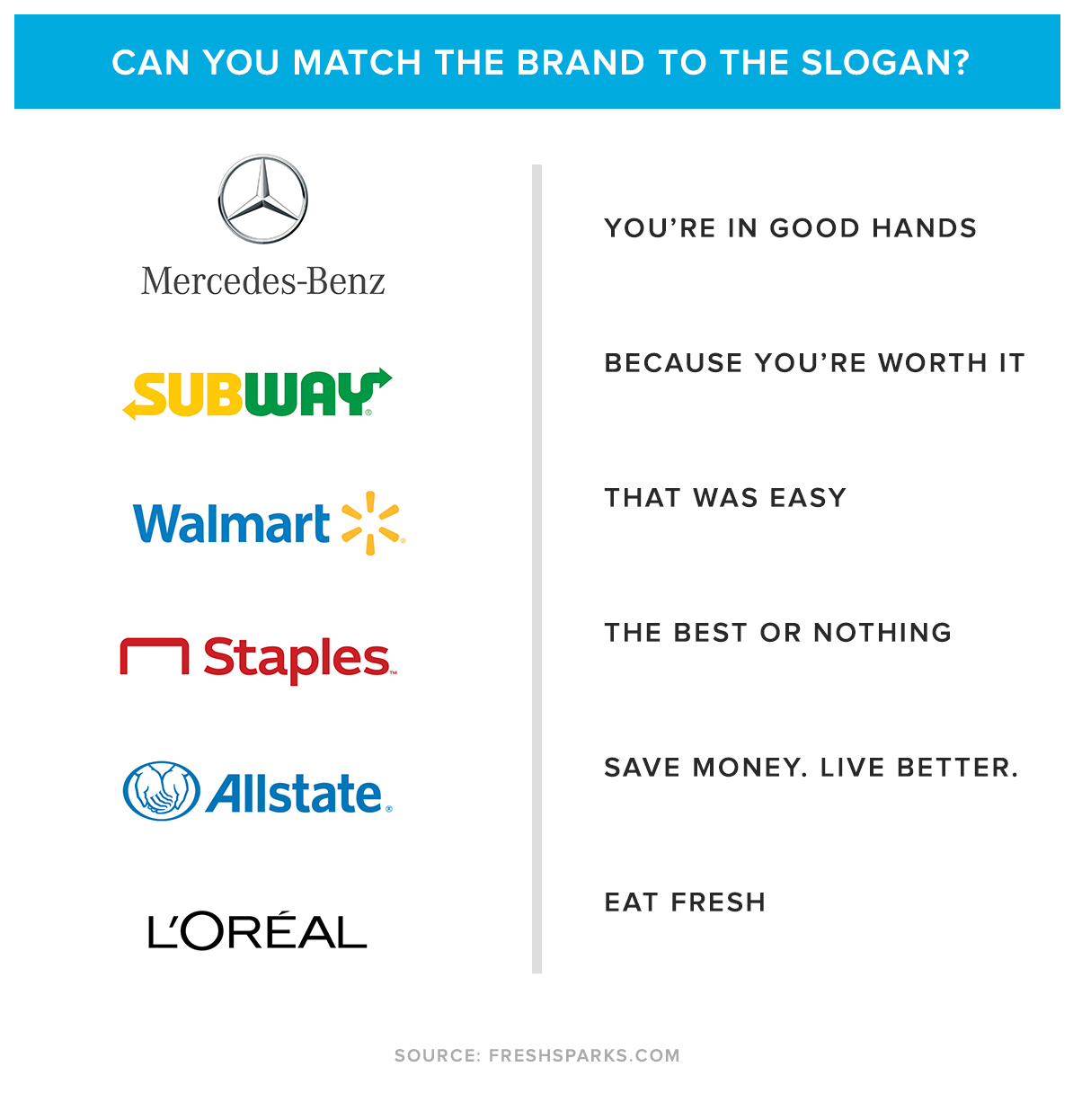
Chances are, you’ve seen many of the above brand logos. But do any of the slogans on the right ring a bell?
Try to match the brand on the left with the phrase on the right. Kudos if you get them all!
Answers are at the end of this blog post.
When creating a brand slogan, keep these points in mind.
- Convey positivity
- Use it to differentiate
- Explain a key benefit
- Make it memorable
General Electric has cycled through no less than 10 taglines since 1912, as the brand has evolved. For those who remember the 1980’s, the brand slogan was:
We bring good things to life.
In 2003, the slogan was changed to:
Inspiration at work.
This new and improved slogan hits home as a tribute to GE founder and inventor, Thomas Edison. And, it also supports all the contributions current GE employees continue to make towards industrial progress.
[click_to_tweet tweet=”When creating a brand slogan: be positive, differentiate, explain a benefit, make it memorable. #branding #smallbiz” quote=”When creating a brand slogan: be positive, differentiate, explain a benefit, make it memorable. “]
DON’T: Make your slogan too long
As you can see, a successful brand slogan can be very short, like the three-word Nike slogan mentioned earlier. Imagine if Nike had tried to over-explain with that slogan.
Which sounds better?
Just Do It
Or:
Just Do It in Our Top-Quality Athletic Shoes
An inspiring phrase for the customer suddenly turns into something that is all about the business. You get the picture.

5. DO: Research current trends
When you are creating a new brand from scratch, you should do market research to see what is happening in your industry. And, what is appealing to your target market.
And actually, this is important to do even when you are an established business so that you can stay current with your branding.
Here’s the deal:
There is an amazing amount of information out there on the internet. Aside from purchasing costly research reports (which is a viable option if you have the budget), it is as simple as going to Google.
In the search bar, type in something like: “market research nutritional supplements”. Or, “customer data health and wellness industry.”
Replace the above example with your specific product, service or industry.
Another quick example could be, “market research pet owners” (45,500,000 results!).
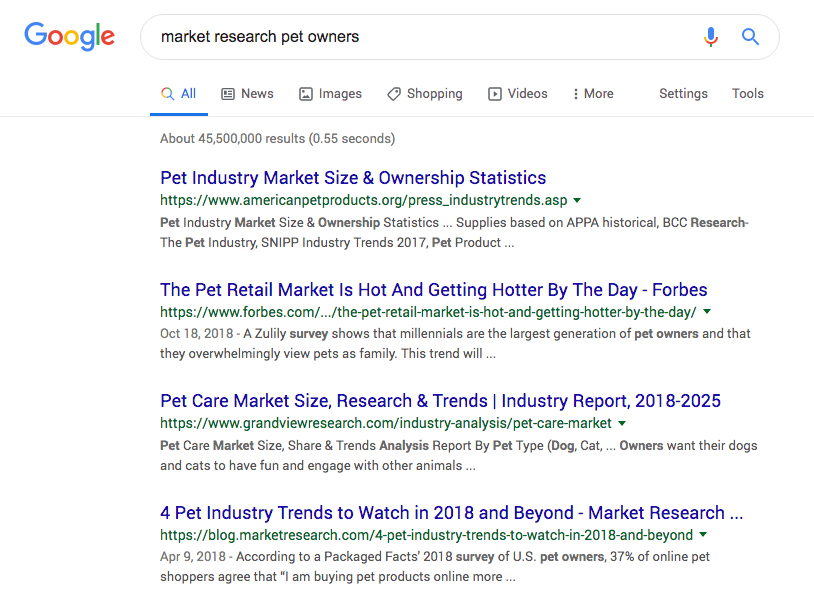
Cull through all the relevant results and start reading. You may have to do some digging, but that is where you can find the gems of information.
You’ll be able to gather data about trends that will help you fine-tune your offering, your target audience, or your messaging.
DON’T: Get too caught up in trends
The caveat to the above is that you shouldn’t get so caught up in trends that you forget your core business and your why. For example, if you are a business selling something that appeals to people who are traditional and nostalgic, then you want to look more towards traditional than trendy.
 |
THE ULTIMATE GUIDE TO BRAND BUILDING Use our step-by-step workbook with tips, templates, and guidance to help build a brand for your business! Find your target audience, research competitors…and much more. |
6. DO: Determine your brand “personality”
Bland doesn’t work too well with brand, unless you are marketing flavorless food.
(Pretty sure that product is a dud.)
Your brand should have a personality or attitude, even a subtle one. Think about some adjectives that might describe your company, and use that as a basis.
Determine on which side of the personality spectrum your brand falls:
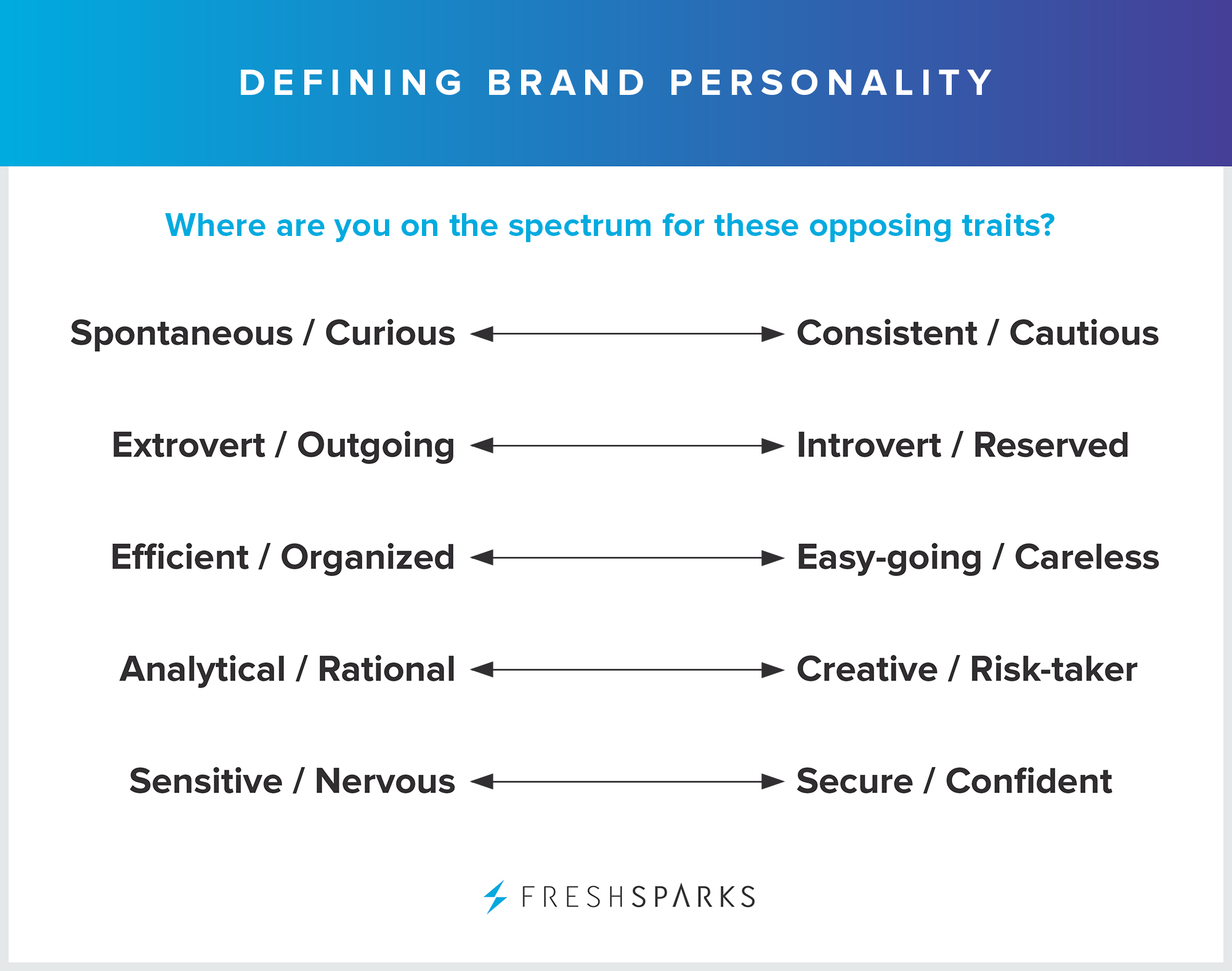
And even further, consider these traits as well:
- Personable or corporate?
- High-energy or careful?
- Modern or traditional?
- Cutting-edge or established?
- Fun or serious?
- Accessible or exclusive?
For example, a consulting firm may focus on high-end, white-glove services. That should be a part of the brand personality…perhaps by being sophisticated or exclusive in nature.
DON’T: Try too hard
You wouldn’t want to go so far with personality that your brand becomes a joke. The stereotypical used car salesman comes to mind!
Your brand personality should be authentic and speak to the target customer. Figure out what attributes your brand has, and how that aligns with the attributes of your buyer persona. This will help your brand engage in a true conversation with prospective leads and existing customers.
7. DO: Develop a unique business culture
A unique culture can become part of your overall business branding and brand personality. What we mean by “culture” consists of how you do business.
How do you treat your employees and customers?
Does your company value teamwork and collaboration?
Is being family-friendly, including generous maternity leave, a part of your corporate culture?
These can all become a part of your business branding.
Bringing your employees on board with your brand’s business culture and values can be the difference in having long-lasting success.
DON’T: Go against your values
Once you have developed a business culture, you need to live it. If you don’t, then you can hurt your brand.
A strong business brand starts from within the company. Ensure that your employees understand and align with the same values the business is built on. Start this with your hiring process, by vetting the right people to bring on board.
Empower, train, recognize and reward your team in support of advocating your brand.
8. DO: Trademark your brand
Coming up with a unique business name is getting harder every day, as there are more entrepreneurs and small businesses. You’ll want to protect your brand from copycats. A trademark protects a symbol, name, word, logo, or design used to represent the manufacturer of goods.
Once you have your brand name, logo, and slogan, you should get it officially trademarked. This involves filing a trademark application, which can be easily done through LegalZoom for $300-500 each.
The official trademark designation will legally protect you if someone tries to steal or copy your original brand assets. Even better, a trademark will never expire.
Before you apply, find out if something is trademarked by searching the trademark database. In the U.S., this is done via the USPTO trademark search.
It’s important to know that a trademark is different from a patent, and it’s best to consult legal counsel if you have a need for more protection of your products or intellectual property.
DON’T: Put TMs everywhere
Regardless of whether you trademark something or not, it can be overkill to put a TM after every mention of your brand name or products. Just don’t overdo it with trademarking all the things.
9. DO: Use a Consistent Voice
In addition to your visual style guide is the voice that you use for your communications as a brand.
Is your voice casual or professional?
Are the blog articles on your website in first person, second person, or third person?
For a financial business brand, such as an accounting firm, you might want to err on being more formal in your communication. Unless you’ve gone the other direction and branded yourself as “The Wacky Accountant.” Hey, it might work as a differentiator.
With the brand voice that you determine fits your brand personality best, you’ll be able to develop a compelling brand story and associated messaging. These are the fundamental pieces of communication you’ll use across all channels, such as your website and social media.
DON’T: Change your voice too frequently
So, let’s say you do run an accounting firm, and you want to set it apart by re-branding it as a fun, “wacky” accounting firm. This is all fine and good, but you may need to give this new voice a try before switching gears suddenly.
Do some testing with your current customer base, to see if the voice resonates with them.
10. DO: Boost your brand
Once you have your brand name, logo, slogan and story, make you sure to promote it. The prettiest logo won’t help a darn bit if nobody sees it!
Build a clean, user-friendly website that clearly explains what your business does for the consumer. Remember to include a call-to-action that points people in the right direction (Buy Now, Schedule a Call, Sign Up). Tell them exactly what to do.
Develop a marketing plan and implement it. Foundation elements of a digital brand strategy should include:
- Content marketing
- Social media marketing
- Email marketing
- Paid advertising
DON’T: Be shy about your brand
Finally, don’t be shy about your business branding, especially if you are a solo entrepreneur. Let people know about your brand and promote it proudly!
Global Businesses with Top 10 Branding
Are you curious about which companies around the world have the most valuable brands? Here’s a quick list of those with top 10 brand value, according to Forbes. Use them for inspiration, or competition!
#1 – Apple
#2 – Google
#3 – Microsoft
#4 – Amazon
#5 – Facebook
#6 – Coca-Cola
#7 – Samsung
#8 – Disney
#9 – Toyota
#10 – McDonald’s
Branding Your Business The Right Way
Business branding from the beginning is one of the best fundamental things to do for long-lasting growth. It’s also something that established companies can turn their attention to for increased brand awareness and trust.
I always say:
More brand trust = more sales.
And who doesn’t want more sales?
[click_to_tweet tweet=”Your brand is the biggest asset your company will own—and the most valuable. #smallbiz #branding” quote=”Your brand is the biggest asset your company will own—and the most valuable.”]
It’s never too late to start branding your business. Use these tips to differentiate, target, and communicate. More importantly, to stay ahead of the competition!
- Have a professional logo designed, but don’t overthink it.
- Understand who your customer is, but don’t try to be everything to everyone.
- Find inspiration from other brands, but don’t rip them off.
- Create a brand slogan or tagline, but don’t make it too long.
- Research current trends, but don’t get caught up in them.
- Determine your brand “personality”, but don’t try too hard.
- Develop a unique business culture, but don’t go against your values.
- Trademark your brand, but don’t put TMs everywhere.
- Use a consistent voice, but don’t change it too frequently.
- Boost your brand, but don’t be shy about it.
What are your favorite small business branding ideas? Have you done something awesome that has helped build your brand?
Share your comments or questions below!
Brand Slogan Quiz Answers:
Mercedes-Benz – The Best or Nothing
Subway – Eat Fresh
Walmart – Save Money. Live Better.
Staples – That Was Easy
Allstate – You’re in Good Hands
LOreal – Because You’re Worth It
 |
THE ULTIMATE GUIDE TO BUILDING A BRAND Use our step-by-step workbook with tips, templates, and guidance to help build a brand for your business! Find your target audience, research competitors…and much more. |
Need branding help? FreshSparks is a branding agency specializing in brand strategy, brand identity, website design, and brand marketing. We can help you with branding your business successfully. Contact us to learn more.
If you liked this post, please share!


Great Article, Thanks its perfect article about Branding solutions
Great article, thanks! Rarely do you see such large and detailed articles. It immediately feels like you understand this. It’s amazing how much you need to do to become a recognizable brand. If suddenly you have any problems with collectors, auto fraud, etc. you can contact this lawyer. He is really an expert in his field.
lets do it, link it Emd and you can learn more furniture.
such a wonderful post to read, thank you for sharing experience and ideas and useful information regarding the brand narrative. keep it up
Thank you for sharing! This is a very well detailed content.
The best way to define your target audience is to consider what they’re interested in, where they’re located, their age, what they think of your brand currently, and how you will attract them to your services or products. Learn more: https://unoiatech.com/brand-messaging-to-grow-your-business/
This is a very interesting post. It’s well worth the effort and am glad. Corporate Branding is everything if a business want to be loved by it’s target audience, stand out from other competitors and grow its revenues.
Hi Sonia, Something awesome I have done for one of my businesses is to brand my content. My favorite branding idea from your blog post is to find inspiration from other brands. Best wishes.
Thanks for the piece of information and I must admit your post is highly educative, Branding service is an essential part of every business.
Thanks for this great piece. It’s an eye opener for me as a startup for agripowermachines for smallholder cocoa farmers in rural area Nigeria. Please enlighten me on how to package my business branding for rural folks with little or no electricity.
.
Such a great post. Thanks for sharing great tips to create and promote your brand.
Radly Bates Digital
Thank you for the feedback! Glad you found it valuable.
Great article! I particularly agree with the point of not trying too hard. Many companies manage to make a mockery of their brand, through over-exposure on social media or using insensitive slogans and catchphrases. The target audience has to be kept in mind throughout.
Thanks, Jessica! One of the key things for brands is to always provide value first. It will result in a business having to do a lot less sales over time. Appreciate your comment and hope to hear more from you!